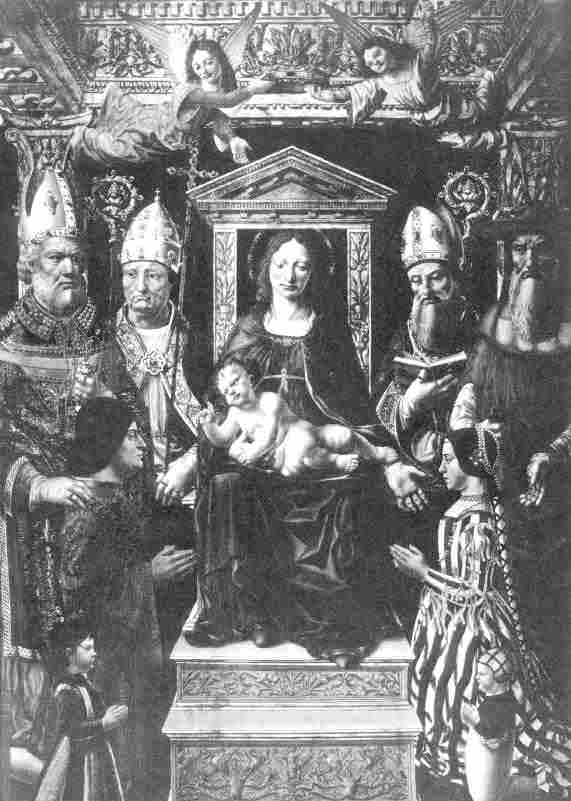
European Royalty: Italian States--Milan

Figure 1.--Here Ludovicio il Moro, Duke of Milan, and his family pay homage to the Madona and Child. I believe it is his son in the lower left corner. Ludovicio invited the king of France to claim Naples. He came to regret this as Charles VIII had an old dynastic claim to the Duchy of Milan. The painting is by Bernardino dei Conti.
|
Milan is believed to have been founded by Celtic tribes, who settled in the northern Italian Po river valley (7th century BC). The Romans as part of their conquest of Italy seized the city (3rd century BC). The Roman legions occupied the city in their northern campaign (222 BC). The city was called Mediolanum, meaning middle of the plain. The city was important because it set astride trade routes linking Rome with northwestern Europe. This until the industrialization of the city in the 19th center was a key factor in the city's prosperity. It was in Milan that Constantine issued the edict granting Christians freedom of worship within the Empire (313 AD). Milan's location as a rich city along established trade routes resulted in pilage and chaos during the barbarian invasions following the fall of Rome. Milan formed a commune town council to givern it (11th century) and achieved considerable growth and prosperity. In part because of the lack of monarchial movement, Milan was involved in ongoing disputes with neighboring tates. The Holy Roman emperor, Frederick I (Barbarossa) launched a campaign to add to his Italian possessions. He attempted to capitalize on internal Italian conflict and attacked Milan (1162). The Italians in a rare show of ynity opposed Emperor. The local townsformed the Lega Lombarda and defeated the Emperor's forces (1176). Milan became dominated by a series of powerful families (mid-13th century). These families included: the Torrianis, the Viscontis, and the Sforzas. Under the these dynasties, Milan grew and became a major force in northern Italy and became known as the Duchy of Milan. The Duchy then came under foreign control. First there was Spanish rule (1535) After the War of the Spanish Successiin, Milan was awarded to Austria under the terms of the Treaty of Utrecht (1713). The Austrian imprint on Milan is large. Emperess Maria Theresa left the city La Scala and the Palazzo Real in her favorite shade of yellow. Major changes came with the French Revolution and Napoleon. Milan was the capital of the Cisalpine Republic (1797). Later Napoleon created the Italian Republic with Milan again its capital (1802). It was in Milan that Napoleon was crowned King of Italy (1805). Napoleon's defeat resulted in the resestablished of the old regimes. The Congress of Vienna awarded Milan to Austria (1814). Austria and France fought a short war (1859). During that war forces commanded by Victor Emmanuel II and Napoleon III defeated the Austrians at the Battle of Magenta. Milan was then incorporated into the Kingdom of Italy (1860).
HBRC

Navigate the Boys' Historical Clothing Web Site royal pages:
[Main Italian states page]
[Main royal pages]
[Austria]
[Belgium]
[Denmark]
[France]
[Germany]
[German states]
[Italy]
[Luxemburg]
[Monaco]
[Netherlands]
[Norway]
[Romania]
[Russia]
[Spain]
[United Kingdom]
Created: May 14, 2004
Last updated: May 14, 2004



